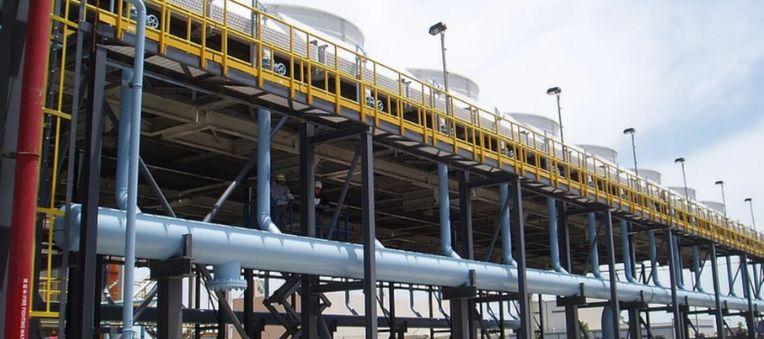Fin fan heat exchangers, also known as air-cooled heat exchangers, are critical components in industrial processes where efficient heat dissipation is essential. These systems use ambient air to cool process fluids, making them ideal for applications where water scarcity or contamination is a concern. Optimizing airflow is crucial to maximizing the performance and efficiency of fin fan heat exchangers. In this article, we explore strategies and best practices for achieving optimal airflow in these systems, emphasizing their benefits and importance in industrial applications.
Understanding Fin Fan Heat Exchangers
Fin fan heat exchangers consist of finned tubes arranged in a vertical or horizontal configuration, with fans mounted at the top to draw ambient air through the fins. This design enhances heat transfer by increasing the surface area available for heat exchange between the process fluid inside the tubes and the surrounding air. Typically made from materials like stainless steel heat exchanger for durability and corrosion resistance, these heat exchangers are suitable for various industries, including petrochemical, power generation, and HVAC.

Importance of Optimizing Airflow
Efficient airflow is critical to the performance and efficiency of fin fan heat exchangers. Proper airflow management ensures that the heat exchanger operates at optimal conditions, maximizing heat transfer rates and minimizing energy consumption. By optimizing airflow, industrial facilities can improve process efficiency, reduce operating costs, and extend the lifespan of equipment.
Strategies for Optimizing Airflow
1. Fan Selection and Configuration
Choose fans that are appropriately sized and configured for the specific requirements of the fin fan heat exchanger system. Consider factors such as airflow volume (CFM – Cubic Feet per Minute), static pressure, and fan efficiency. Proper fan selection ensures adequate air circulation through the finned tubes, enhancing heat dissipation and minimizing energy consumption.
2. Cleanliness and Maintenance
Maintain cleanliness of the finned surfaces and fan blades to prevent dust, debris, or vegetation from obstructing airflow. Regular cleaning routines should be implemented to remove contaminants that can reduce heat transfer efficiency. Inspect and clean air intake screens and louvers to ensure unobstructed airflow into the heat exchanger.
3. Airflow Distribution
Optimize airflow distribution across the finned tubes to maximize heat transfer efficiency. Ensure uniform airflow velocity and distribution patterns to prevent hot spots and achieve consistent cooling performance. Use computational fluid dynamics (CFD) analysis or airflow modeling tools to optimize fan placement and orientation for uniform air distribution.
4. Fan Speed and Control
Implement fan speed controls or variable frequency drives (VFDs) to adjust fan speed based on heat load and ambient conditions. Variable fan speed control allows for energy savings by reducing fan power consumption during periods of lower heat load or cooler ambient temperatures. Automated controls can optimize fan operation for maximum efficiency and operational flexibility.
5. Air Quality and Ambient Conditions
Monitor ambient air quality and environmental conditions that may affect fin fan heat exchanger performance. Factors such as humidity, temperature fluctuations, and airborne particulates can impact heat transfer efficiency. Install weather protection features or air filtration systems to maintain optimal air quality and protect heat exchanger components from environmental contaminants.
Benefits of Optimizing Airflow
6. Enhanced Energy Efficiency
Optimizing airflow in fin fan heat exchangers reduces energy consumption by improving heat transfer efficiency. Efficient airflow management minimizes the workload on fans and enhances overall system performance, leading to lower operational costs and reduced carbon footprint.
7. Extended Equipment Lifespan
Proper airflow optimization reduces wear and tear on fin fan heat exchanger components, prolonging equipment lifespan and minimizing maintenance requirements. By preventing overheating and mechanical stress, optimized airflow contributes to reliable operation and fewer downtime incidents.

Conclusion
Fin fan heat exchangers are essential for industries seeking efficient cooling solutions without water usage or contamination concerns. Optimizing airflow in these systems is crucial for maximizing heat transfer efficiency, reducing energy consumption, and extending equipment lifespan. By implementing strategies such as proper fan selection, regular maintenance, airflow distribution optimization, and advanced control systems, industrial facilities can achieve significant improvements in process efficiency and operational reliability.
As industries continue to prioritize sustainability and operational efficiency, investing in the optimization of fin fan heat exchanger airflow becomes increasingly important. By leveraging the benefits of efficient airflow management, businesses can enhance their competitive edge, reduce environmental impact, and achieve long-term cost savings.


